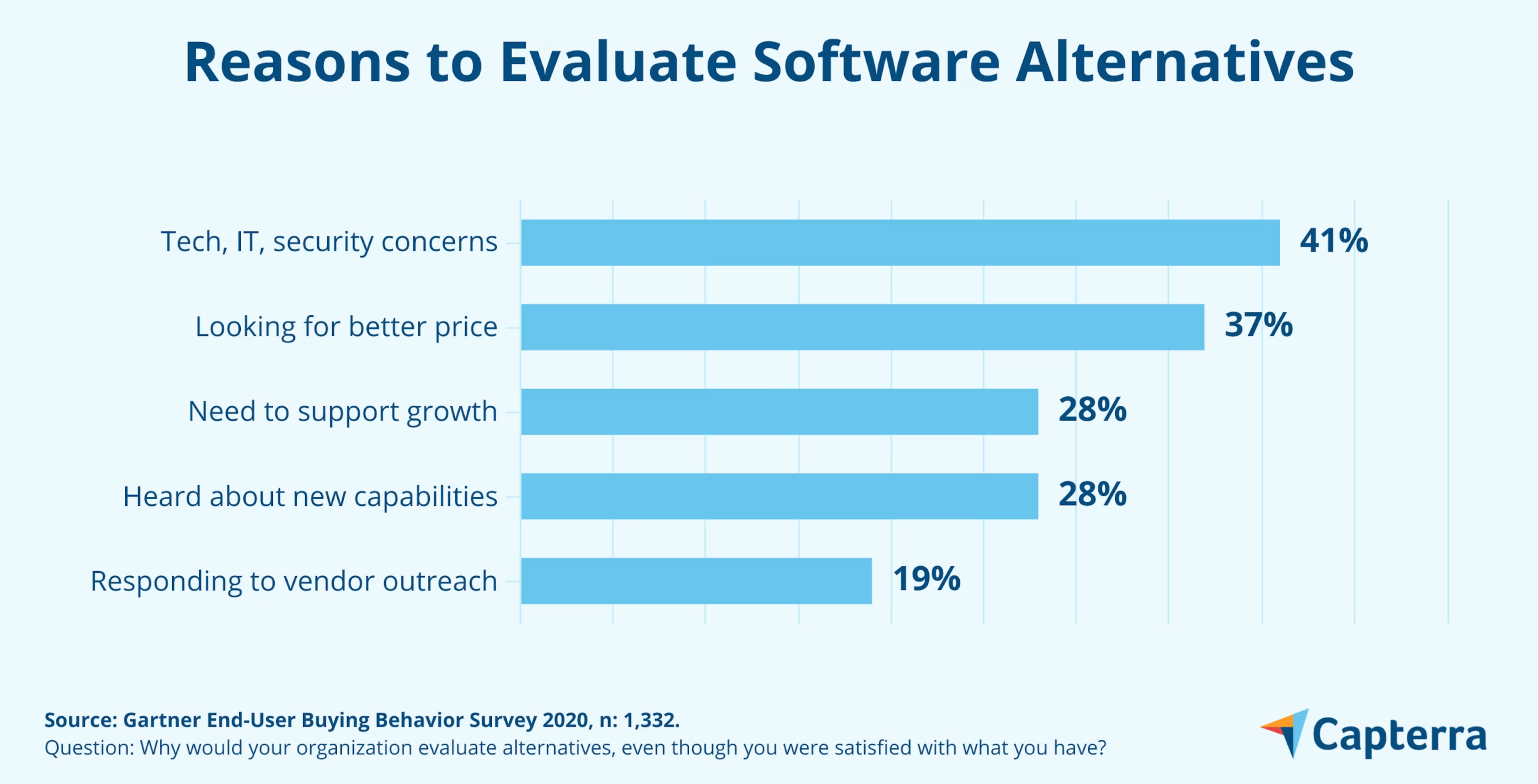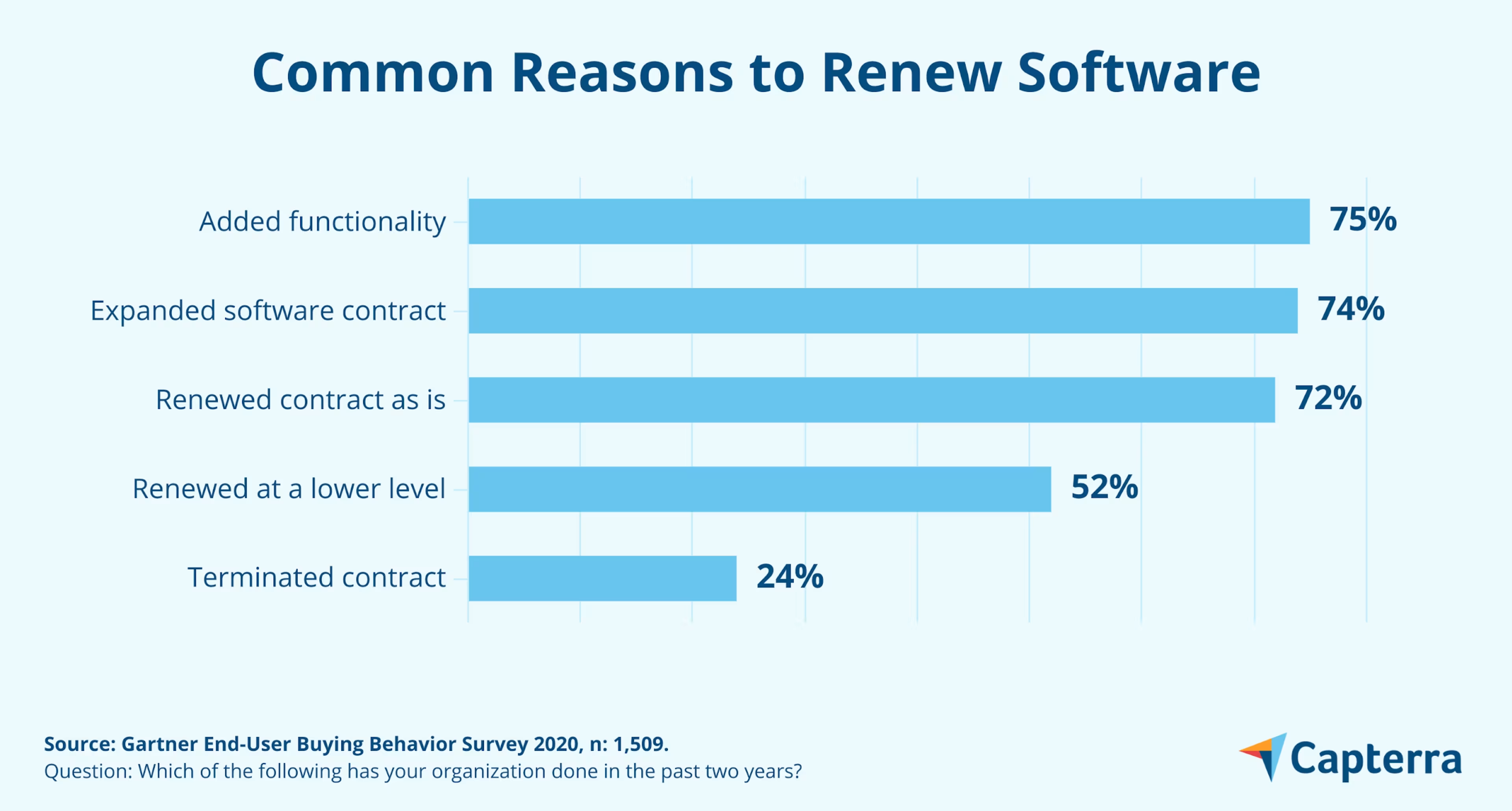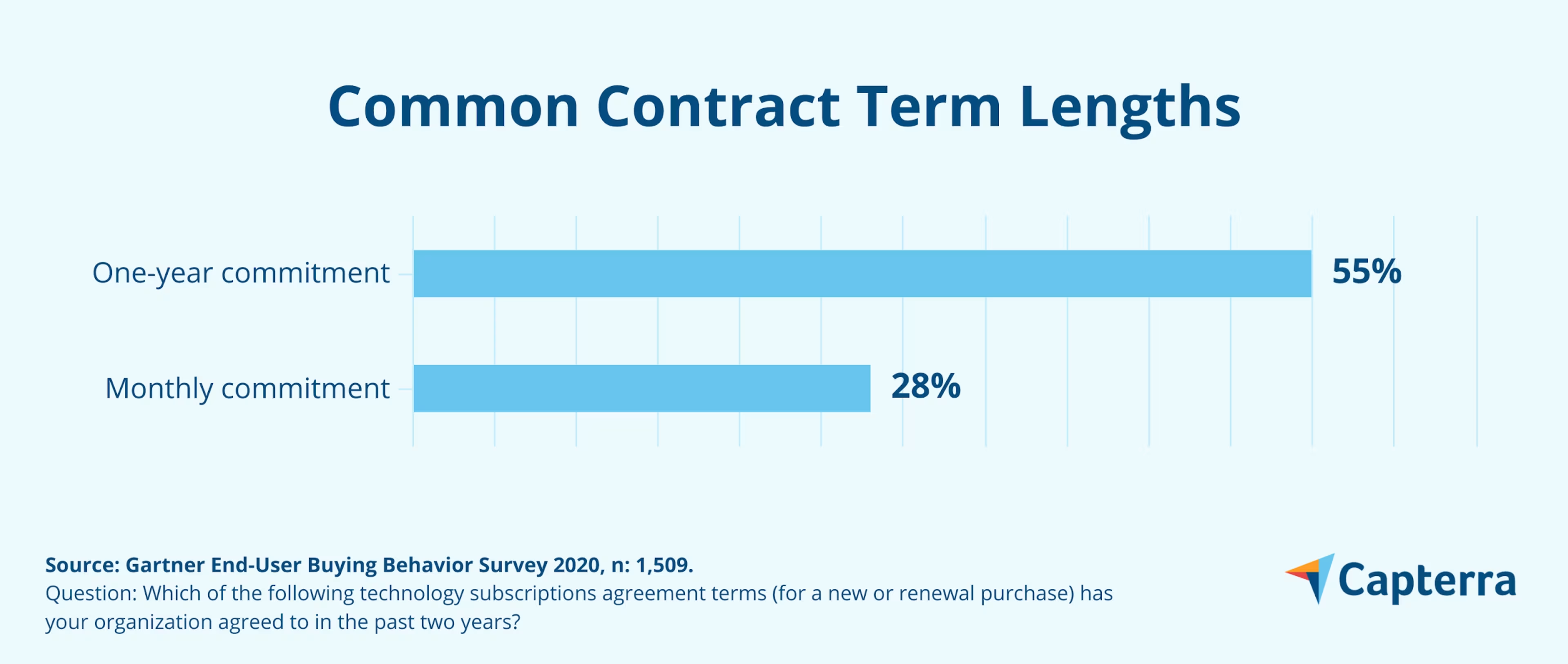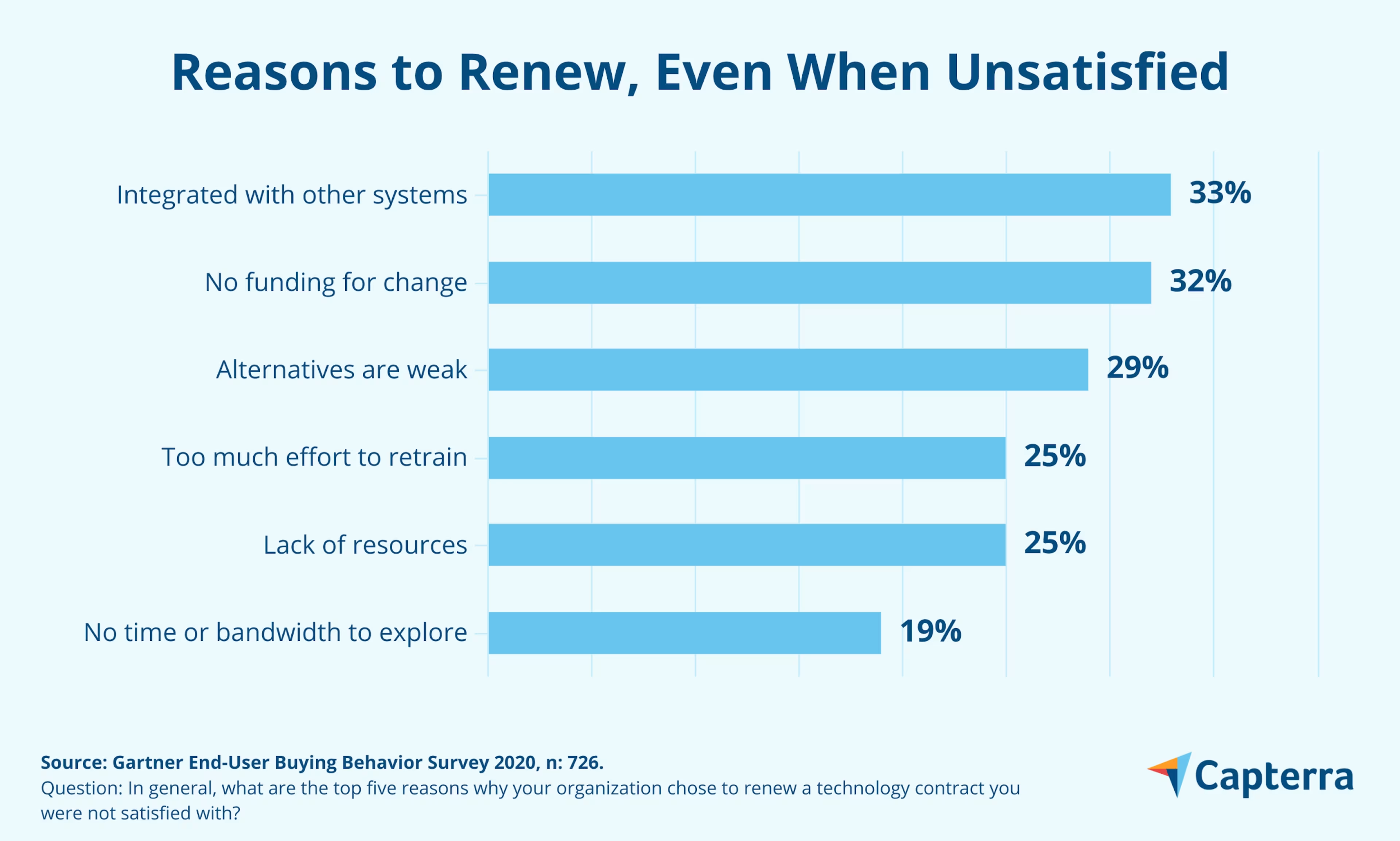
Use your renewal period to explore the software market and discover new functionality for your business.
Your software subscription period is almost over. Do you renew that subscription without looking around the market for better options? Even if you’re happy with the system, the renewal is an opportunity to confirm that you have the best software available.
The 2020 Gartner survey of software buyers worldwide reveals how many businesses approach the subscription renewal process. We’ve analyzed these results to form four clear actions to take when you reach the end of a software contract. (Full report available to Gartner clients)
Treat each renewal as a new software search
Over 80% of survey respondents investigate alternatives in depth or at a cursory level, whether they are satisfied with their current software or not.
Don’t casually renew your current software without investigating new options. It may be reasonable to simply renew, but you could be missing out on new, valuable functionality that emerged recently.
Pay attention to the signs that indicate that you need to find new software—if even one of these apply, you need to review your options in the software market.
The vast majority of companies use each renewal period as a chance to look around at other systems, just to find out if competitors are offering anything new that could add value to their business. Nearly half of companies surveyed (45%) perform an in-depth evaluation of software before renewing.

How to take action:
So what should you be looking for? If you have any major complaints about the current system, start there—both technical and security issues are often the biggest reasons to consider other options.
Aside from those, consider whether your company fits into either of these common situations:
The return on investment (ROI) for the software doesn’t match your expectations.
You have experienced business challenges such as using a single login for multiple users or complicated workflows that slow projects down.
Finally, your current vendor may have reached out to share new capabilities, or you’ve heard about them from peers. Any of these are valid reasons to evaluate new options, so give yourself two to three months to do research.
Prioritize features to “rightsize” and save money
In normal economic conditions, 64% of respondents indicate that they’ve downgraded or terminated at least one subscription agreement.
If most businesses evaluate new software during each renewal period, what exactly are they doing? The majority tend to add features or expand services. But for many, the goal is to get the same functionality for less money.

So as you review new functionality, use this chance to consider which features of your software are truly driving your goals in this new business environment, and determine which functionality you may not need now.
Software providers ultimately want to retain your business for as long as possible, so they have a motivation to demonstrate the value of your relationship and deliver the specific set of features you want, even if you’re paying less.
How to take action:
Break down features into required, valuable, and optional buckets. Request that the vendor show you how pricing could change if some optional features were removed.
The renewal is also a great time to review your need for support—after a year or so with new software, you should be able to reduce your spend on support services as your team gains proficiency. Ask if the vendor has a support plan that will work best for you.
Use our article on the best practices for completing a software purchase to download a template that allows you to list and score these features, then learn how to evaluate the true costs for software as you move toward the renewal date.
It’s OK to avoid long commitments
Fifty-five percent of buyers commit to contracts of only one-year duration or less.
Back when software was only installed on local computers, agreeing to a multi-year contract made sense. Switching to a different system could take months to get up and running, but today’s cloud-based software puts more power in the hands of buyers.
Software-as-a-Service (SaaS) products offer a more attractive option for small and midsize companies—they’re cheaper to adopt with subscription pricing, and the flexibility means you can access the system from any device with a web browser. This makes switching among a few different systems much more simple.

Each vendor will have their own policies for contract lengths and often offer a cheaper package for commitments of at least a year, so make sure to understand your options.
How to take action:
Before renewing, review your current software contract to understand your company’s obligations when terminating. You should see some common clauses:
Termination for convenience or cause: ”For convenience” means you can terminate for any reason, and “for cause” means you can terminate only if the vendor violates the agreement.
Early-termination fees: Vendors will often include fees and other penalties for ending a contract early that offsets the vendor’s costs for losing a client.
Post-termination requirements: When terminating a software agreement, whether early or not, you may have some obligations. For example, the contract should cover how to collect and remove all your data from the system.
Understand the termination clauses in your contract. If you’re satisfied with the product after one agreement, you could choose to commit to a longer term contract. Shorter contract lengths may cost more, but grants you the flexibility to change software quickly.
Don’t settle for a less-than-ideal system
Seven hundred twenty-six respondents (52%) indicate that they had renewed at least one subscription agreement, even though they were not satisfied with it.
More than half of the companies in the survey have renewed a subscription for software they didn’t even like. A variety of situations may make your current, but less-than-ideal, system the most appropriate choice.

But you don’t have to settle for “less than ideal”. Starting with exploring Capterra’s more than 750 software categories is a great first step. Each product profile includes overall ratings with scores for ease of use, customer service, features, and value for money, alongside detailed user reviews, to significantly speed up the time needed to identify options.
How to take action:
Start your research early. In the final year of your subscription contract, set up recurring meetings for a software evaluation team, made up of your key stakeholders in the company, to determine:
Pain points with the current system
Alternative systems with similar functionality
These help you understand your options ahead of renewal time. Check out step one in our tips for acing your software negotiation—the same people you need for a negotiation team should be included in these meetings.
How to put this advice into action
Renewal time is a great opportunity to review different systems. But if you’re happy with the current software, your simplest move is to renew. Use these tips as a guide for either situation:
- If you choose to stay with your current system: Consider which features or services you can afford to remove to "rightsize" Rightsizing, in relation to software, is the process of removing or adding functionality to optimize the system for your business needs and budget.the system and save money. Review our 6 Steps for a Successful Software Contract Negotiation.
If you decide to find another system: A year out from the end of your contract, gather peers and employees to understand the pain points users have with the current system. Then perform research to identify alternatives that can eliminate those pain points. Review our 3 Powerful Ways to Get Buy-In for New Software.